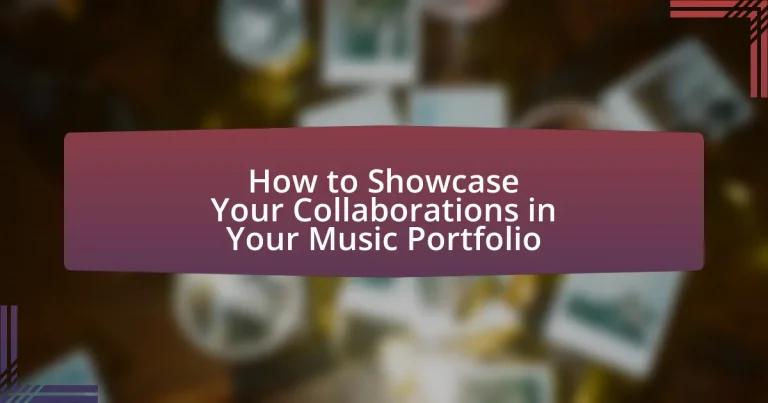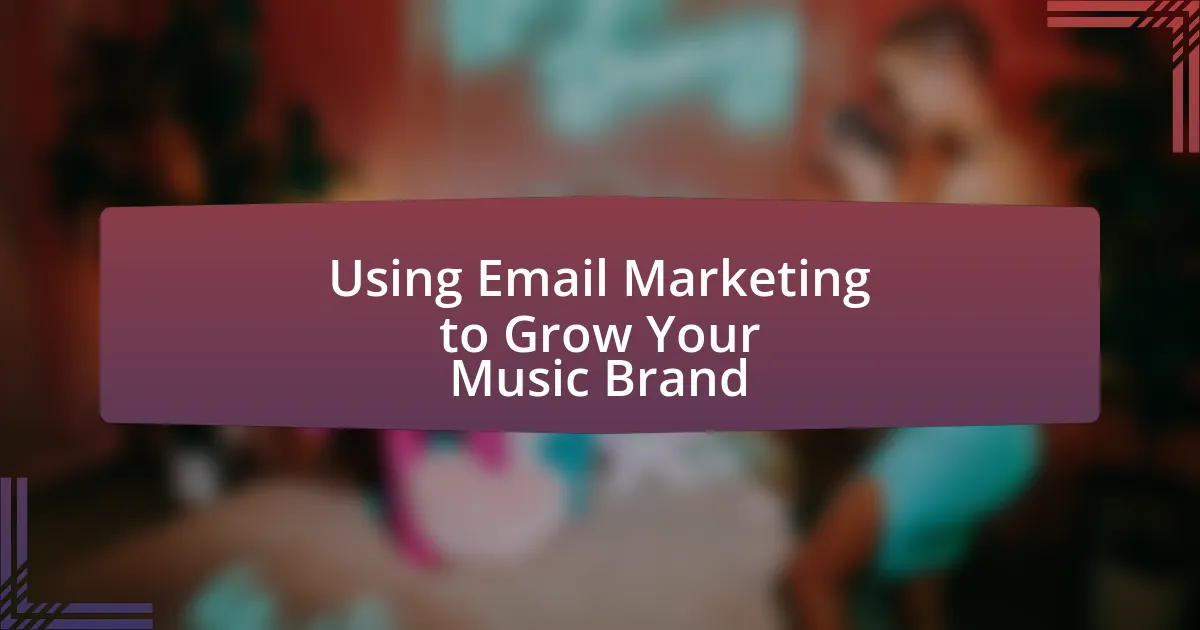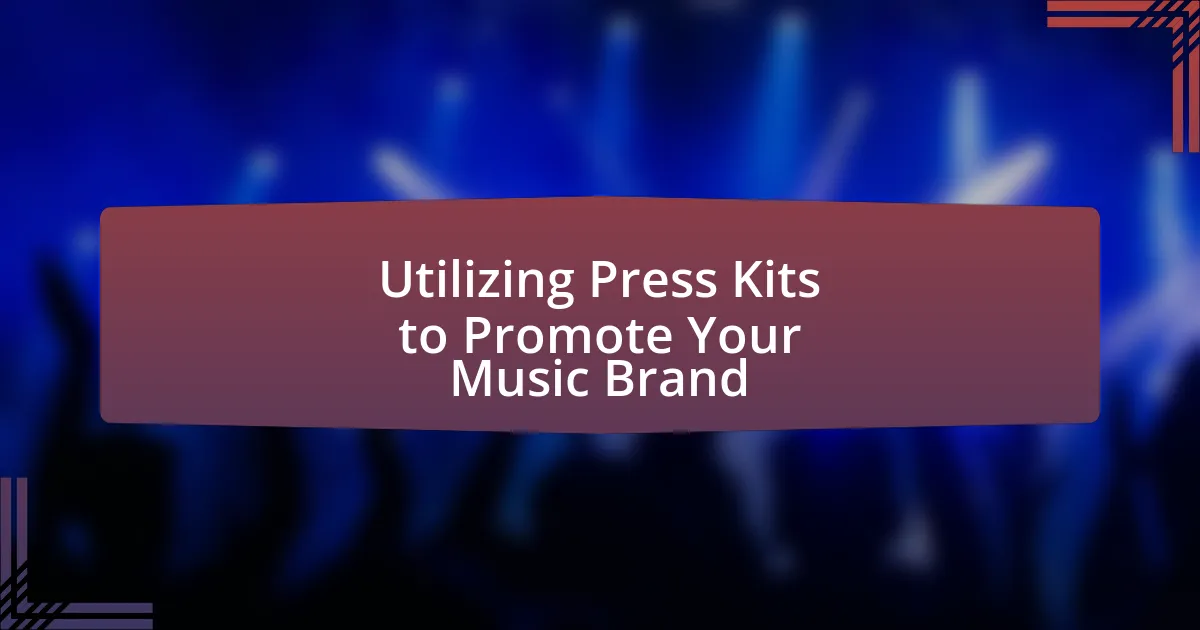The article focuses on the importance of showcasing collaborations in a music portfolio, emphasizing how joint projects with other artists can enhance credibility, creativity, and audience reach. It outlines the significance of collaborations in the music industry, detailing how they can lead to innovative sounds and increased visibility through shared fan bases. Key elements for effectively presenting collaborations include providing context, utilizing multimedia, and maintaining a cohesive brand image. The article also highlights best practices and common pitfalls to avoid, ensuring that artists can effectively communicate their collaborative efforts while preserving their individual artistry.
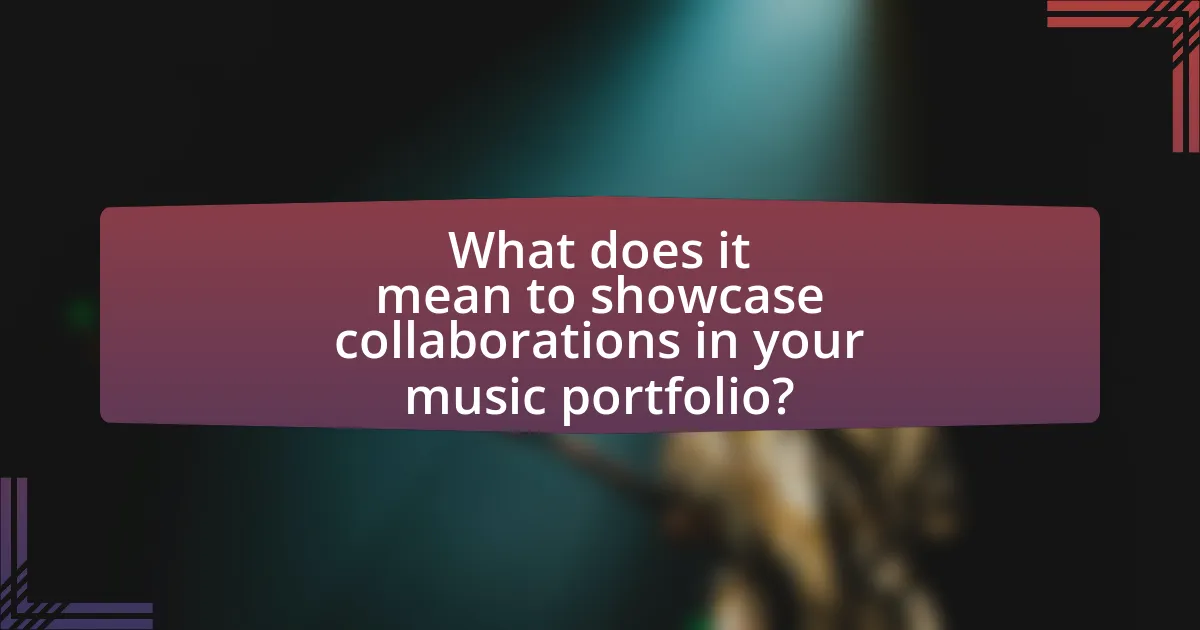
What does it mean to showcase collaborations in your music portfolio?
Showcasing collaborations in your music portfolio means presenting joint projects or works created with other artists to highlight your versatility and network within the music industry. This practice demonstrates your ability to work collaboratively, which is essential in a field where partnerships often lead to innovative and diverse musical outcomes. For instance, featuring tracks that include contributions from well-known artists can enhance your credibility and attract a wider audience, as collaborations often leverage the fan bases of all involved.
Why are collaborations important in the music industry?
Collaborations are important in the music industry because they enhance creativity and broaden audience reach. When artists collaborate, they combine diverse skills and influences, resulting in innovative sounds that can attract listeners from different genres. For instance, the collaboration between Jay-Z and Linkin Park on the “Collision Course” album showcased how blending hip-hop with rock can create a unique musical experience, leading to commercial success and critical acclaim. Additionally, collaborations often leverage the fan bases of each artist, increasing exposure and potential sales; for example, the song “Despacito” featuring Justin Bieber significantly boosted its global popularity, demonstrating the power of collaborative efforts in expanding market reach.
How do collaborations enhance your musical credibility?
Collaborations enhance musical credibility by associating artists with established names and diverse styles, which can elevate their reputation. When an emerging artist collaborates with a well-known musician, it signals to audiences and industry professionals that the artist is recognized and valued within the music community. For instance, collaborations often lead to increased exposure through shared fan bases, as seen when artists like Jay-Z and Kanye West teamed up on “Watch the Throne,” resulting in critical acclaim and commercial success. This association not only boosts the artist’s visibility but also reinforces their legitimacy in the industry, as collaborations are often viewed as endorsements of talent and skill.
What unique perspectives do collaborations bring to your work?
Collaborations bring diverse viewpoints and skills to my work, enhancing creativity and innovation. By working with different artists, I gain insights into various musical styles and techniques, which can lead to unique soundscapes and compositions. For instance, a study by the National Endowment for the Arts found that collaborative projects often result in higher levels of artistic experimentation and risk-taking, ultimately enriching the final output. This blending of ideas not only broadens my artistic horizons but also fosters a sense of community and shared purpose in the creative process.
What elements should be included when showcasing collaborations?
When showcasing collaborations, it is essential to include the names of all collaborators, the nature of the collaboration, and the specific contributions made by each party. This clarity helps potential listeners and industry professionals understand the dynamics of the project. Additionally, including links to the collaborative work, such as audio or video samples, enhances visibility and engagement. Providing context about the collaboration, such as the goals, inspirations, and outcomes, further enriches the presentation. For instance, a successful collaboration might highlight how the combined efforts led to a unique sound or innovative approach, which can be substantiated by audience reception or critical reviews.
How can you effectively present your collaborative projects?
To effectively present your collaborative projects, clearly outline each project’s objectives, contributions, and outcomes. Start by providing a concise description of the project, including the roles of each collaborator and the specific skills or expertise they brought to the table. Use visual aids such as images, videos, or audio clips to enhance engagement and illustrate the project’s impact. Additionally, include metrics or feedback that demonstrate the project’s success, such as audience reach, critical acclaim, or sales figures. This structured approach not only highlights your contributions but also showcases the collaborative effort, making it easier for viewers to understand the value of the project.
What types of media can be used to showcase collaborations?
Various types of media can be used to showcase collaborations, including video content, audio recordings, social media posts, and written articles. Video content, such as behind-the-scenes footage or music videos, visually captures the collaborative process and final product. Audio recordings, like joint tracks or live performances, provide an auditory representation of the collaboration. Social media posts can highlight key moments and interactions, engaging audiences in real-time. Written articles or blog posts can offer in-depth insights into the collaboration, detailing the creative journey and outcomes. Each media type effectively communicates the essence of the collaboration to the audience.
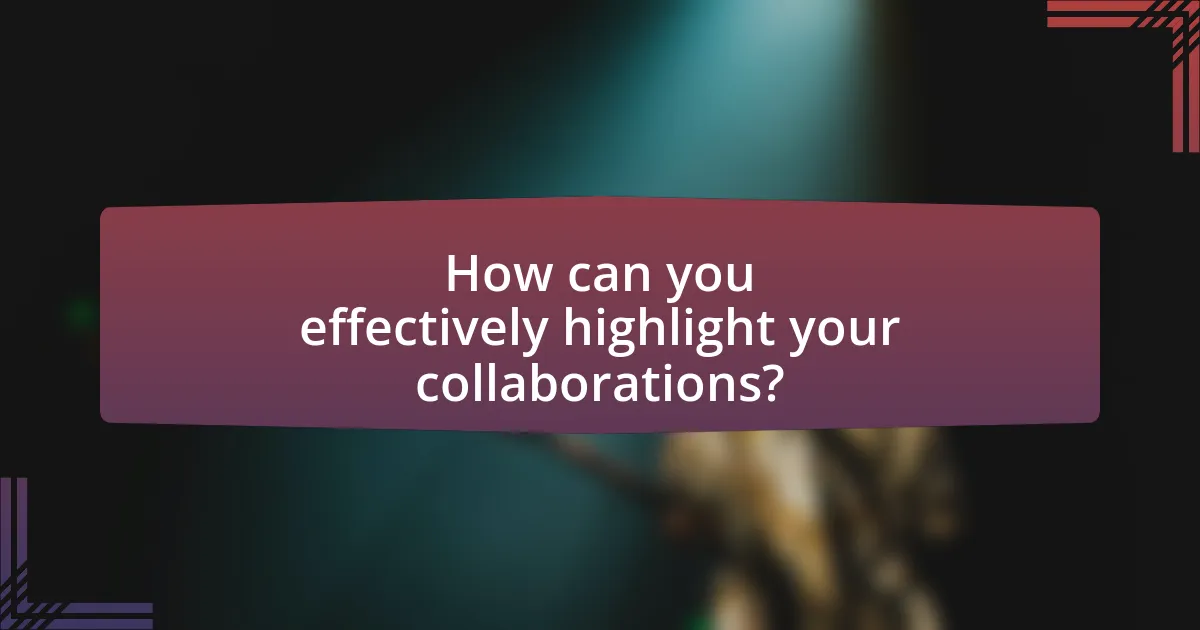
How can you effectively highlight your collaborations?
To effectively highlight your collaborations, showcase specific projects and the roles you played in them. For instance, include detailed descriptions of each collaboration, emphasizing your contributions, the skills you utilized, and the outcomes achieved. Providing links to the work, such as streaming platforms or videos, can enhance visibility. Additionally, mentioning notable collaborators and any recognition received, such as awards or chart positions, adds credibility and context to your contributions. This approach not only demonstrates your collaborative skills but also illustrates the impact of your work within the music industry.
What strategies can be employed to feature collaborations prominently?
To feature collaborations prominently, artists should utilize dedicated sections in their music portfolios that highlight each collaboration with detailed descriptions and visuals. This approach allows potential listeners and industry professionals to easily identify and appreciate the collaborative efforts. For instance, including high-quality images, audio snippets, and background stories about the collaboration can enhance engagement. Additionally, leveraging social media platforms to share behind-the-scenes content and tagging collaborators can increase visibility and reach. Research indicates that artists who actively promote their collaborations on multiple platforms experience a 30% increase in audience engagement, demonstrating the effectiveness of these strategies.
How can storytelling enhance the presentation of your collaborations?
Storytelling enhances the presentation of collaborations by creating an emotional connection that engages the audience. When artists share the narrative behind their collaborations, it provides context and depth, allowing listeners to understand the creative process and the significance of the partnership. Research indicates that stories can increase retention of information by up to 65%, making the collaboration more memorable. By framing the collaboration within a compelling story, artists can highlight the unique aspects of their work, fostering a stronger bond with their audience and enhancing the overall impact of their music portfolio.
What role do visuals play in showcasing your collaborative work?
Visuals play a crucial role in showcasing collaborative work by enhancing engagement and conveying complex ideas quickly. They provide a visual representation of the collaborative process, making it easier for audiences to understand the contributions of each participant. For instance, infographics can summarize project milestones, while images or videos of collaborative sessions can illustrate teamwork dynamics. Research indicates that visuals can increase information retention by up to 65%, demonstrating their effectiveness in communication. Thus, incorporating visuals not only enriches the presentation of collaborative efforts but also improves audience comprehension and retention of the showcased work.
How can you leverage social media to showcase collaborations?
You can leverage social media to showcase collaborations by creating engaging content that highlights the partnership and its outcomes. This includes sharing behind-the-scenes footage, collaborative posts, and joint live sessions that demonstrate the creative process and final results. For instance, platforms like Instagram and TikTok allow for visual storytelling, which can effectively capture the essence of the collaboration. Additionally, using relevant hashtags and tagging collaborators increases visibility and engagement, as evidenced by studies showing that posts with tags receive 30% more engagement than those without.
What platforms are most effective for sharing collaborative projects?
The most effective platforms for sharing collaborative projects include SoundCloud, Bandcamp, and YouTube. SoundCloud allows artists to upload and share their music easily, fostering community engagement through comments and reposts. Bandcamp provides a platform for artists to sell their music directly to fans, enabling collaboration visibility and revenue generation. YouTube serves as a powerful medium for sharing music videos and behind-the-scenes content, reaching a broad audience and enhancing collaborative visibility. These platforms are widely used in the music industry, with SoundCloud boasting over 76 million users and Bandcamp reporting over 800,000 artists, demonstrating their effectiveness in showcasing collaborative projects.
How can you engage your audience through social media during collaborations?
Engaging your audience through social media during collaborations can be achieved by creating interactive content that encourages participation. For instance, hosting live Q&A sessions or behind-the-scenes streams allows fans to connect directly with the artists involved, fostering a sense of community. Additionally, utilizing polls and questions in stories can solicit audience opinions on collaboration-related topics, making them feel included in the creative process. Research indicates that interactive content can increase engagement rates by up to 70%, highlighting its effectiveness in capturing audience interest.
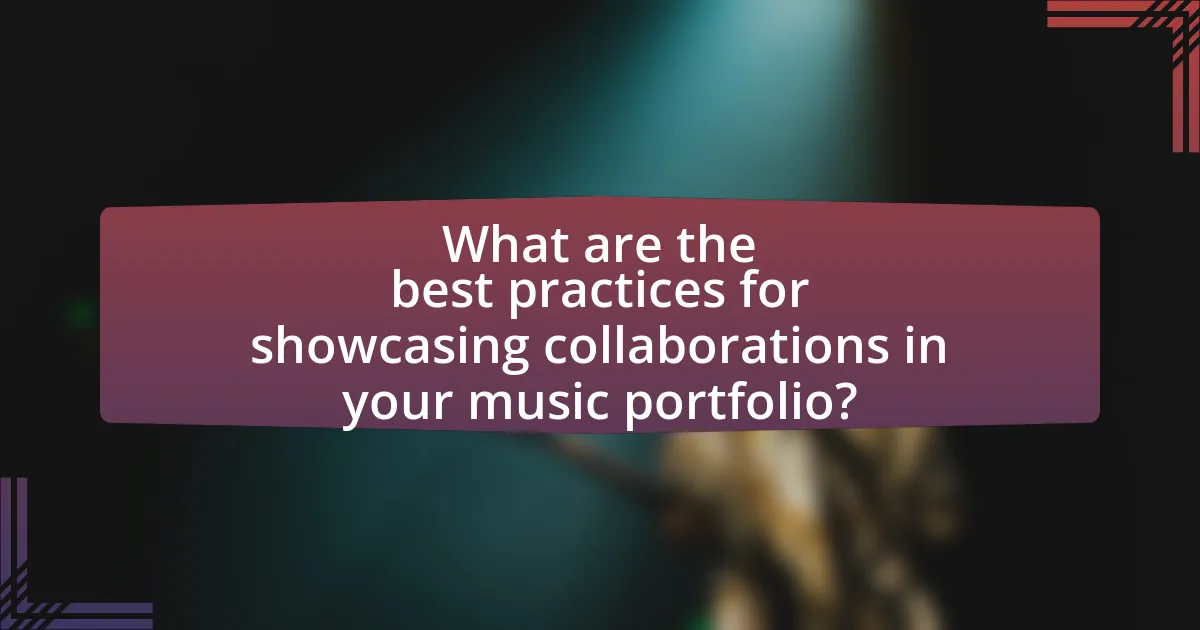
What are the best practices for showcasing collaborations in your music portfolio?
The best practices for showcasing collaborations in your music portfolio include highlighting key projects, providing context for each collaboration, and using multimedia elements. Highlighting key projects allows potential listeners and industry professionals to quickly identify significant works that demonstrate your collaborative skills. Providing context, such as the role you played in each collaboration and the impact of the project, helps to clarify your contributions and the value of the partnership. Utilizing multimedia elements, like audio clips, videos, or visuals from the collaboration, enhances engagement and provides a richer experience for viewers. These practices are supported by industry standards that emphasize the importance of clarity and engagement in music portfolios.
How can you ensure your portfolio is cohesive while showcasing collaborations?
To ensure your portfolio is cohesive while showcasing collaborations, maintain a consistent visual and thematic style throughout your work. This can be achieved by using a unified color palette, typography, and layout that reflects your personal brand, regardless of the collaborators involved. For instance, if your collaborations span different genres, select a common element, such as a specific graphic motif or a signature logo, to tie the pieces together. Research indicates that cohesive branding can enhance audience recognition and engagement, as seen in studies by the American Marketing Association, which highlight that consistent presentation increases trust and familiarity among viewers.
What tips can help maintain a consistent brand image across collaborations?
To maintain a consistent brand image across collaborations, establish clear brand guidelines that define your visual identity, tone, and messaging. These guidelines should be shared with all collaborators to ensure alignment in promotional materials, social media posts, and overall communication. Consistency in elements such as logos, color schemes, and fonts reinforces brand recognition and trust among your audience. Research indicates that brands with consistent presentation across all platforms can see a revenue increase of up to 23%, highlighting the importance of uniformity in branding efforts.
How can you balance personal style with collaborative influences?
To balance personal style with collaborative influences, an artist should integrate their unique sound with elements introduced by collaborators. This can be achieved by identifying key aspects of their personal style, such as signature melodies or lyrical themes, and then selectively incorporating collaborative ideas that enhance rather than overshadow these elements. For instance, a musician might maintain their vocal delivery while adapting the instrumentation or arrangement suggested by a collaborator, ensuring that their individual identity remains prominent. This approach allows for a harmonious blend of influences, fostering creativity while preserving authenticity.
What common mistakes should you avoid when showcasing collaborations?
When showcasing collaborations, avoid the mistake of neglecting to credit all contributors appropriately. Failing to acknowledge the roles of each collaborator can lead to misunderstandings and damage professional relationships. Additionally, presenting collaborations without context can confuse your audience; providing background information about the project enhances understanding and appreciation. Lastly, avoid using low-quality visuals or audio, as this can undermine the perceived value of the collaboration; high-quality presentations reflect professionalism and respect for the work involved.
How can overemphasis on collaborations detract from your individual artistry?
Overemphasis on collaborations can detract from individual artistry by overshadowing personal style and unique expression. When artists prioritize collaborative projects excessively, they may dilute their distinct voice and creative vision, leading to a homogenized sound that aligns more with group dynamics than individual artistry. Research indicates that artists who frequently collaborate may struggle to maintain a recognizable brand, as their work becomes intertwined with others, making it difficult for audiences to identify their personal contributions. This phenomenon can result in a loss of authenticity, as the artist’s individual narrative and emotional depth may be compromised in favor of collective goals.
What pitfalls should you watch out for in presenting collaborative work?
When presenting collaborative work, one should watch out for misattribution of credit, which can undermine the contributions of all collaborators involved. Misattribution often occurs when the roles and contributions of each collaborator are not clearly defined, leading to confusion about who contributed what. For instance, a study by the American Psychological Association highlights that clear communication of individual roles in collaborative projects enhances recognition and satisfaction among team members. Additionally, failing to maintain a cohesive narrative can dilute the overall impact of the presentation, as disparate elements may not resonate with the audience. Therefore, it is crucial to ensure that each collaborator’s contributions are accurately represented and that the presentation maintains a unified theme.
What practical tips can enhance your collaboration showcase?
To enhance your collaboration showcase, focus on presenting clear, engaging visuals and concise descriptions of each project. High-quality images or videos of performances, along with well-written summaries that highlight your role and contributions, can effectively communicate the essence of the collaboration. Additionally, including testimonials from collaborators or audience feedback can provide credibility and context, demonstrating the impact of your work. Research indicates that portfolios with visual elements and social proof are more likely to attract attention and interest, making these strategies essential for a compelling showcase.
